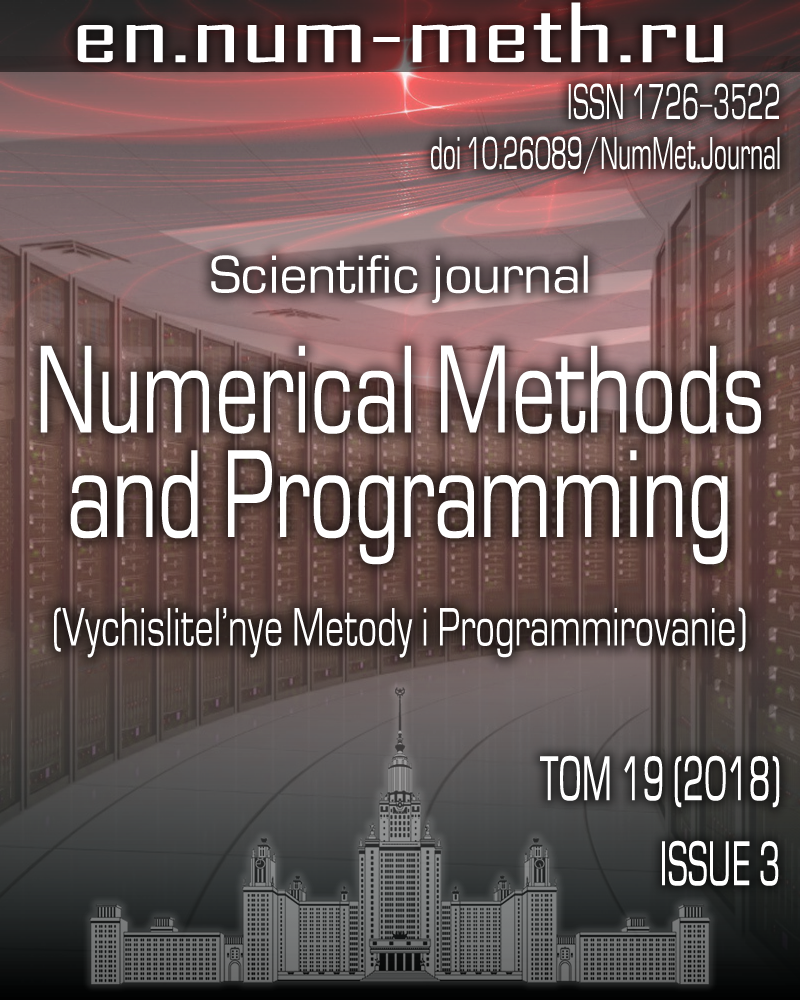DOI: https://doi.org/10.26089/NumMet.v19r319
Deformation of cylindrical cavities in plane-parallel potential flows with circulation and under the action of mass forces
Keywords:
cumulative jets
plane-parallel flow
boundary element method
quadrature formulas without saturation
circulation
Abstract
The problems of cumulative jet formation in plane-parallel potential flows of a perfect incompressible fluid within cylindrical cavities are considered. A new numerical algorithm is proposed on the basis of the boundary element method. The approximation is based on quadrature formulas without saturation. The novelty of this paper is to study the potential flows with nonzero circulation and to derive an analog of the momentum conservation law for such flows. The process of the cavity rise in a heavy fluid is also studied.
Published
2018-05-22
Issue
Section
Section 1. Numerical methods and applications
References
- N. D. Baikov and A. G. Petrov, “Formation of a Cumulative Jet in the Plane-Parallel Flow of a Perfect Fluid,” Vestn. Mosk. Univ., Ser. 1: Mat. Mekh., No. 5, 42-47 (2017) [Moscow Univ. Mech. Bull. 72 (5), 119-123 (2017)].
- A. G. Petrov, “Quadrature Formulas for Periodic Functions and Their Application to the Boundary Element Method,” Zh. Vychisl. Mat. Mat. Fiz. 48 (8), 1344-1361 (2008) [Comput. Math. Math. Phys. 48 (8), 1266-1283 (2008)].
- A. G. Petrov, “Saturation-Free Numerical Scheme for Computing the Flow Past a Lattice of Airfoils and the Determination of Separation Points in a Viscous Fluid,” Zh. Vychisl. Mat. Mat. Fiz. 51 (7), 1326-1338 (2011) [Comp. Math. Math. Phys. 51 (7), 1239-1250 (2011)].
- A. G. Petrov and I. I. Potapov, “Computation of Forces Acting on Bodies in Plane and Axisymmetric Cavitation Flow Problems,” Zh. Vychisl. Mat. Mat. Fiz. 56 (2), 318-331 (2016) [Comp. Math. Math. Phys. 56 (2), 320-333 (2016)].
- A. G. Petrov and S. V. Sanduleanu, “Simulation of Electrochemical Machining Using the Boundary Element Method with No Saturation,” Zh. Vychisl. Mat. Mat. Fiz. 56 (10), 1810-1820 (2016) [Comp. Math. Math. Phys. 56 (10), 1793-1802 (2016)].
- O. V. Voinov and V. V. Voinov, “Numerical Method of Calculating Nonstationary Motions of an Ideal Incompressible Fluid with Free Surfaces,” Dokl. Akad. Nauk SSSR 221 (3), 559-562 (1975) [Sov. Phys. Dokl. 20 (3), 179-182 (1975)].
- E. A. Karabut, A. G. Petrov, and E. N. Zhuravleva, “Semi-Analytical Study of the Voinovs Problem,” Euro. J. Appl. Math. 33 (2018).
doi 10.1017/S0956792518000098 - J. M. Boulton-Stone, “A Comparison of Boundary Integral Methods for Studying the Motion of a Two-Dimensional Bubble in an Infinite Fluid,” Comput. Methods Appl. Mech. Eng. 102 (2), 213-234 (1993).

